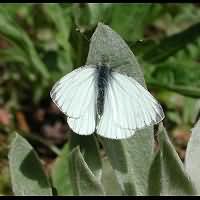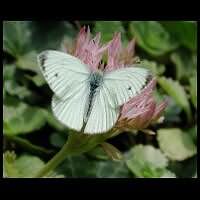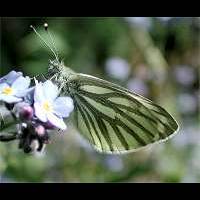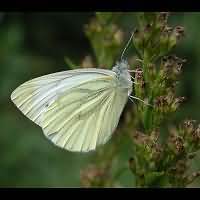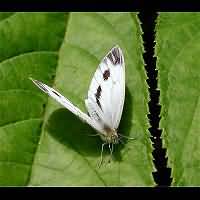[All pictures of garden wildlife on this page are thumbnails. Click on any thumbnail for a large format to be displayed.]
Green-veined White (Pieris napi)
The Green-veined White is also known as the Mustard White. It can be found in all moderate climat zones of the northern hemisphere, including Japan and Northern America. Except for Northern America this is a very common species. It is a rather small species, having a wingspan of 35 to 45 mm. The species looks like some other whites, particularly the Small White. Still it is easily identified by looking at the underside of the wings: the veins are clearly marked greenish or blackish. The spring generation especially has strongly emphasized veins, like the animal in the top picture. Later generations are bleakly marked at times, like in the 2nd picture from the top.
The Green-veined White is not considered a serious pest, for it seldom eats cabbage. Caterpillars are found on cresses and mustard mainly. Adults are atrrackted by all flowering plants and are often plentiful in our gardens. The first generation is frequently seen on dandelions, later generations often visit thistles. In ordinary gardens this is the smallest of all whites and often the most common. On top males of this species are white, showing but one black dot. In the first generation however this dot is often absent, like shown in the top picture. In later generations the dot may be absent as well or very bleached.
The Mustard White is a very variable species. In females, bottom picture, markings may be absent, like in the males, but females showing more black than white also exist. Scientists still fight over the question whether the one species actually consists of various closely related species or whether all variations are just natural and local appearances of the one species. In all cases though, females are richly marked: the tip of the wing is mostly dark and there are two spots or dots visible. The lower dot is sometimes connected to a black smear near the lower edge of the wing. The markings in the first generation may look rather grey, while the summergenerations are usually with very dark markings. The Green-veined White female resembles the Large White a lot, but is always much smaller.
The Green-veined White is a very common species, flying in two or three generations from March to October. In the subtropical regions it may appear in March, but in the temperate zones the first usually appear by the middle or the end of April. It is abundant in May, July and August. Like many other butterflies it usually feeds and rests holding the wings together in an upright position. In some cases the sexes can still be told apart having their wings upright, as the black spot on the males wing is not or hardly visible on the wings back side, while the dot of the female is very striking, even on the back side. You have to be careful not to be mistaken, for the specimen in the last but one picture does look like a richly marked Small White!

© Copyright 1998-2024 gardensafari.net (Hania Berdys)

 English / engels
English / engels  Dutch / nederlands
Dutch / nederlands